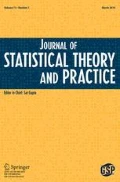Abstract
Under the multinomial logit model, designs for choice experiments are usually based on an a priori assumption that either only the main effects of the factors or the main effects and all two-factor interaction effects are to be estimated. However, in practice, there are situations where interest lies in the estimation of main plus some two-factor interaction effects. For example, interest on such specified two-factor interaction effects arise in situations when one or two factor(s) like price and/or brand of a product interact individually with the other factors of the product. For two-level choice experiments with n factors, we consider a model involving the main plus all two-factor interaction effects, with our interest lying in the estimation of the main effects and a specified set of two-factor interaction effects. The two-factor interaction effects of interest are either (i) one factor interacting with each of the remaining n − 1 factors or (ii) each of the two factors interacting with each of the remaining n − 2 factors. For the two models, we first characterize the information matrix and then construct universally optimal choice designs for choice set sizes 3 and 4.
Similar content being viewed by others
References
Burgess, L., and D. J. Street. 2003. Optimal designs for 2k choice experiments. Communications in Statistics—Theory and Methods 32 (11):2185–206.
Chiu, W.-Y., and P. W. M. John. 1998. D-optimal fractional factorial designs. Statistics & Probability Letters 37 (4):367–73.
Das, A. and R. Singh. 2016. A unified approach to choice experiments. Technical Report, IIT Bombay, https://doi.org/dspace.library.iitb.ac.in/jspui/handle/100/18429.
Demirkale, F., D. Donovan, and D. J. Street. 2013. Constructing D-optimal symmetric stated preference discrete choice experiments. Journal of Statistical Planning and Inference 143 (8):1380–91.
Dey, Α., and R. Mukerjee. 1999. Inter-effect orthogonality and optimality in hierarchical models. Sankhya 61 (3):460–68.
Dey, Α., and C.-Y. Suen. 2002. Optimal fractional factorial plans for main effects and specified two-factor interactions: A projective geometric approach. Annals of Statistics 30 (5):1512–23.
Grafihoff, U., H. Grofimann, H. Holling, and R. Schwabe. 2003. Optimal paired comparison designs for first-order interactions. Statistics 37 (5):373–86.
Grafihoff, U., H. Großmann, H. Holling, and R. Schwabe. 2004. Optimal designs for main effects in linear paired comparison models. Journal of Statistical Planning and Inference 126 (1):361–76.
Großmann, H. and R. Schwabe. 2015. Design for discrete choice experiments. In M. Morris, J. Stufken, and D. Bingham. Handbook of design and analysis of experiments, ed. A. Dean, 787–831. Boca Raton, FL: Chapman and Hall/CRC.
Hedayat, A. S., and Η. Pesotan. 1992. Two-level factorial designs for main effects and selected two-factor interactions. Statistica Sinica 2 (2):453–64.
Hedayat, A. S., and H. Pesotan. 1997. Designs for two-level factorial experiments with linear models containing main effects and selected two-factor interactions. Journal of Statistical Planning and Inference 64 (1):109–24.
Huber, J., and K. Zwerina. 1996. The importance of utility balance in efficient choice designs. Journal of Marketing Research 33:307–17.
Kiefer, J. 1975. Construction and optimality of generalized Youden designs. In A survey of statistical design and linear models (Proc. Internat. Sympos., Colorado State Univ., Ft. Collins, Colo., 1973), 333–53. Amsterdam, The Netherlands: North-Holland.
Singh, R., F.-S. Chai, and A. Das. 2015. Optimal two-level choice designs for any number of choice sets. Biometrika 102 (4):967–73.
Street, D. J., and L. Burgess. 2007. The construction of optimal stated choice experiments: Theory and methods, vol. 647. Hoboken, NJ: John Wiley & Sons.
Street, D. J., and L. Burgess. 2012. Designs for choice experiments for the multinomial logit model. In Design and analysis of experiments, special designs and applications, ed. K. Hinkelmann, vol. 3, 331–78. Hoboken, NJ: John Wiley & Sons.
Wu, C, and Y. Chen. 1992. A graph-aided method for planning two-level experiments when certain interactions are important. Technometrics 34 (2):162–75.
Author information
Authors and Affiliations
Corresponding author
Rights and permissions
About this article
Cite this article
Chai, FS., Das, A. & Singh, R. Optimal two-level choice designs for estimating main and specified two-factor interaction effects. J Stat Theory Pract 12, 82–92 (2018). https://doi.org/10.1080/15598608.2017.1329101
Received:
Accepted:
Published:
Issue Date:
DOI: https://doi.org/10.1080/15598608.2017.1329101


